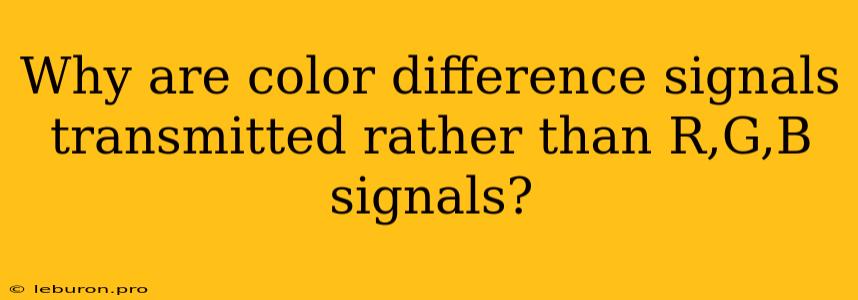The human eye is incredibly sensitive to color, and our perception of the world is heavily influenced by it. In the digital realm, capturing and reproducing these colors accurately is crucial for a wide range of applications, from photography and video to computer graphics and virtual reality. While it might seem intuitive to transmit raw red, green, and blue (RGB) values for each pixel, the reality is that color difference signals offer a more efficient and robust approach. This article explores the reasons behind this choice, delving into the advantages of transmitting color difference signals over raw RGB signals.
The Limitations of Raw RGB Signals
While RGB signals represent the fundamental components of color, transmitting them directly presents several challenges. Firstly, RGB signals are highly susceptible to noise and interference. Even minor fluctuations in transmission can lead to significant color distortions, particularly in areas of high contrast. Secondly, raw RGB signals require a large bandwidth for transmission, leading to increased data storage and processing demands. This can be a significant burden, especially for applications that require high resolution and frame rates.
The Efficiency of Color Difference Signals
Color difference signals, also known as YUV or YCbCr, address these limitations by encoding color information in a more efficient and robust manner. The core idea is to separate luminance (Y) – representing the overall brightness of the image – from chrominance (Cb, Cr) – representing the color information. This separation enables a more efficient representation of color information, as the human eye is more sensitive to luminance variations than color variations.
YUV: A Closer Look
The YUV color space represents the separation of luminance and chrominance.
- Y represents the luminance, essentially the brightness or grayscale value of a pixel. It is often referred to as luma.
- U and V represent the chrominance, containing information about the color hue and saturation. They are sometimes referred to as chroma.
This separation allows for a more efficient representation of color information because:
-
Reduced Bandwidth: Since the human eye is more sensitive to luminance, transmitting Y at a higher resolution than U and V is sufficient for preserving perceived color fidelity. This significantly reduces the bandwidth required for transmission.
-
Increased Noise Resistance: The separation of luminance and chrominance makes it easier to filter out noise and interference, as noise typically affects both components equally. By focusing on the Y component, we can effectively reduce noise without affecting the perceived color of the image.
How Color Difference Signals Work
The conversion from RGB to YUV is achieved through a matrix multiplication, effectively transforming the three RGB channels into three YUV channels. The YUV channels can then be encoded, transmitted, and decoded to reconstruct the original RGB image.
The Subsampling Technique
To further reduce bandwidth, a technique called subsampling is often employed. Subsampling involves reducing the resolution of the chrominance signals (U and V) compared to the luminance signal (Y). The most common subsampling techniques are 4:2:0, 4:2:2, and 4:4:4, with 4:2:0 being the most widely used for its efficiency.
- 4:4:4: All components (Y, U, V) have the same resolution, resulting in the highest quality but also the highest bandwidth.
- 4:2:2: The chrominance components are reduced to half the resolution of the luminance component.
- 4:2:0: The chrominance components are further reduced to a quarter of the resolution of the luminance component, resulting in the lowest bandwidth but potentially lower quality.
Applications of Color Difference Signals
Color difference signals are widely used in various applications, including:
- Digital Television Broadcasting: The vast majority of television broadcasts utilize YUV encoding to reduce transmission bandwidth and ensure consistent image quality.
- Video Compression Standards: Video compression standards like MPEG-2, MPEG-4, and H.264 heavily rely on YUV encoding for efficient compression and transmission.
- Computer Graphics: Color difference signals are frequently used in graphics applications like image editing software and game engines to efficiently represent and manipulate color information.
Conclusion
Color difference signals, like YUV, offer a significant advantage over transmitting raw RGB signals by providing a more efficient and robust representation of color information. This efficiency stems from the separation of luminance and chrominance, allowing for targeted bandwidth reduction and improved noise resistance. By leveraging the human eye's sensitivity to luminance and strategically reducing the resolution of chrominance components through subsampling, color difference signals ensure high-quality color reproduction while minimizing transmission bandwidth and storage requirements. This makes them the preferred choice for a wide range of applications where accurate color representation is essential.
